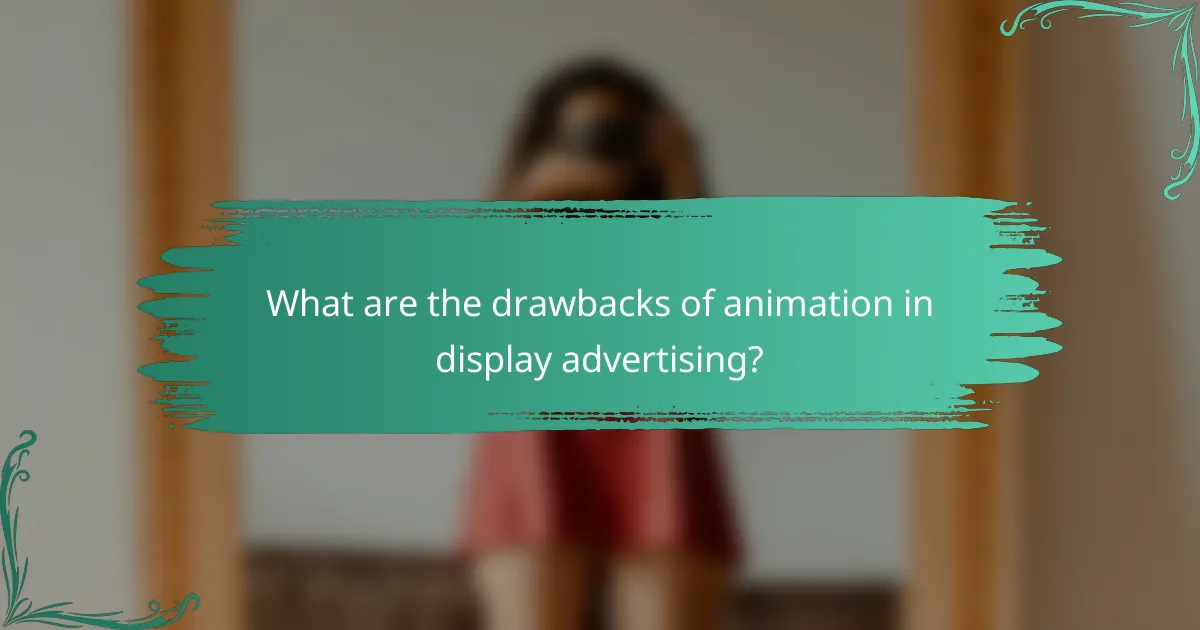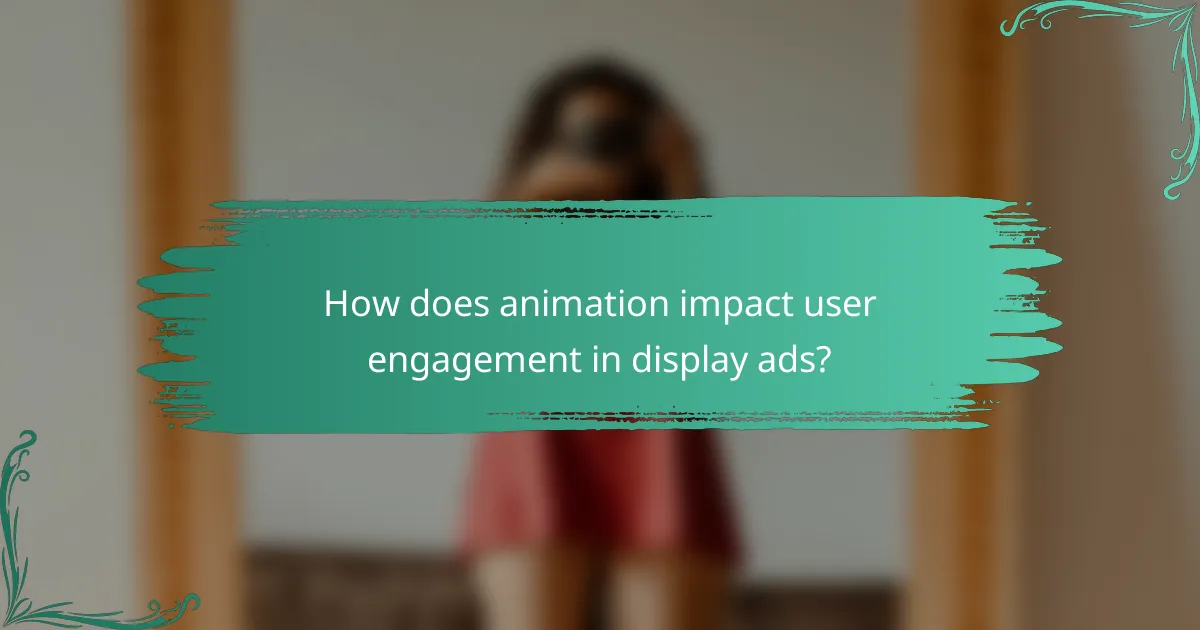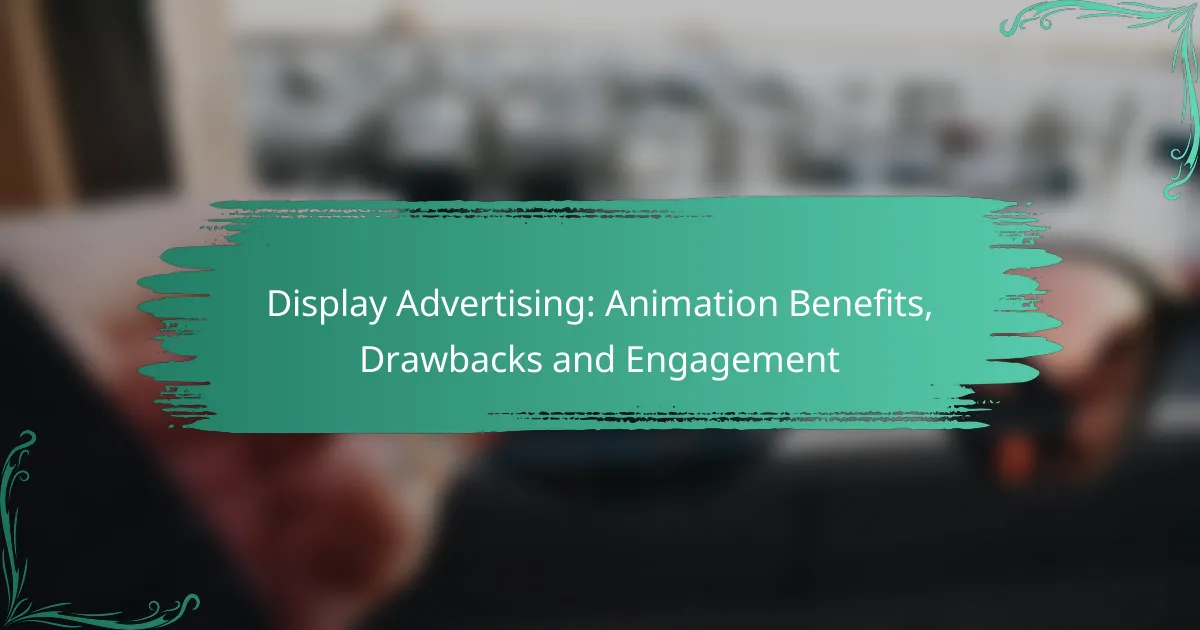Animation in display advertising serves as a powerful tool for capturing attention and enhancing user engagement. While it can significantly improve interaction and effectiveness by making ads more visually appealing, there are also potential drawbacks such as longer loading times and compatibility issues that advertisers must consider.

What are the benefits of animation in display advertising?
Animation in display advertising offers several advantages, including capturing attention and enhancing user interaction. By incorporating movement, ads can stand out in a crowded digital landscape, leading to improved engagement and effectiveness.
Increased user engagement
Animated ads tend to attract more viewer attention compared to static images. The movement draws the eye, encouraging users to interact with the content, which can lead to higher click-through rates. For instance, a simple animated banner can outperform a static one by a noticeable margin in terms of user engagement.
Enhanced brand storytelling
Animation allows brands to convey complex messages and narratives more effectively. Through visual storytelling, brands can illustrate their values, products, or services in a dynamic way that resonates with audiences. For example, a short animated clip can succinctly explain a product’s benefits in a way that text alone cannot achieve.
Higher conversion rates
Using animation can lead to increased conversion rates by making calls to action more compelling. Animated elements can guide users through a desired action, such as signing up for a newsletter or making a purchase. Studies suggest that well-designed animated ads can boost conversions significantly, sometimes by double digits.
Improved visual appeal
Animation enhances the overall aesthetic of display ads, making them more visually appealing. This can help brands stand out and create a memorable impression. A vibrant, animated ad can evoke emotions and attract attention more effectively than a static image, leading to a stronger brand presence.
Better message retention
Viewers are more likely to remember animated ads compared to their static counterparts. The combination of movement and sound can create a more immersive experience, aiding in message retention. Research indicates that consumers may recall animated ads at higher rates, making them a valuable tool for brand recall.

What are the drawbacks of animation in display advertising?
Animation in display advertising can lead to several drawbacks that may hinder its effectiveness. Key issues include longer loading times, potential user distraction, compatibility problems across devices, and higher production costs.
Longer loading times
Animations often require larger file sizes, which can significantly increase loading times for ads. This delay can frustrate users, leading to higher bounce rates and lower engagement. Aim for animations that load within a few seconds to maintain user interest.
To mitigate loading issues, consider optimizing file formats and using compressed images or videos. Tools like Adobe Animate or online compressors can help reduce file sizes without sacrificing quality.
Potential for user distraction
While animations can attract attention, they can also distract users from the main message of the ad. Overly flashy or complex animations may divert focus, causing users to miss the call to action. Strive for a balance between eye-catching visuals and clear messaging.
To avoid distraction, keep animations subtle and relevant to the content. Test different styles to see which maintains user engagement without overwhelming them.
Compatibility issues across devices
Animations may not display consistently across all devices and browsers, leading to a fragmented user experience. Some mobile devices or older browsers may struggle to render complex animations, resulting in broken ads. Always test your animations on multiple platforms before launch.
Utilizing responsive design principles can help ensure animations work well on various screen sizes. Consider fallback options, such as static images, for devices that cannot support animations.
Higher production costs
Creating high-quality animations typically involves greater time and resources, leading to increased production costs. Hiring skilled animators or using advanced software can add to the budget, making it essential to weigh the potential return on investment.
To manage costs, consider simpler animations or templates that require less customization. Collaborating with freelancers or using in-house talent can also help keep expenses down while still achieving effective results.

How does animation impact user engagement in display ads?
Animation significantly enhances user engagement in display ads by capturing attention and encouraging interaction. Animated elements can make ads more visually appealing, leading to increased click-through rates and better overall performance.
Boosts click-through rates
Animated display ads tend to achieve higher click-through rates (CTR) compared to static ads. This is primarily because movement attracts the eye, prompting users to engage with the content. Studies suggest that animated ads can increase CTR by a notable margin, often in the range of 20-50% over their static counterparts.
To maximize the effectiveness of animated ads, keep animations short and relevant. A duration of 15-30 seconds is generally optimal, as longer animations may lead to viewer drop-off. Ensure that the call-to-action is clear and prominent to guide users toward the desired action.
Encourages social sharing
Animation can make display ads more shareable on social media platforms. Engaging animations often evoke curiosity and can prompt users to share the content with their networks, thereby increasing brand visibility. Ads that tell a story through animation or feature humor tend to perform particularly well in this regard.
To enhance shareability, consider incorporating elements that resonate with your target audience. For instance, using relatable characters or scenarios can encourage users to share the ad, amplifying its reach without additional costs.
Facilitates emotional connection
Animated ads can create a stronger emotional connection with viewers compared to static ads. By using storytelling techniques and relatable characters, animations can evoke feelings that resonate with the audience, making the brand more memorable. This emotional engagement can lead to increased brand loyalty and customer retention.
When designing animated ads, focus on the narrative and emotional tone. Use colors, music, and character expressions that align with your brand’s identity and the message you want to convey. This alignment helps in creating a cohesive experience that resonates with viewers and encourages them to act.

What are the best practices for using animation in display advertising?
Effective use of animation in display advertising enhances engagement and captures attention, but it requires careful consideration of several best practices. Focus on clarity, relevance, and user experience to maximize the benefits while minimizing potential drawbacks.
Keep animations short and relevant
Animations should be concise, ideally lasting only a few seconds, to maintain viewer interest without causing distraction. Aim for animations that complement the message rather than overshadow it, ensuring they are directly related to the product or service being advertised.
For instance, a quick product reveal or a brief demonstration of functionality can effectively engage users. Avoid lengthy animations that may frustrate viewers or lead to increased load times, which can negatively impact user experience.
Ensure mobile compatibility
With a significant portion of users accessing ads via mobile devices, ensuring animations are optimized for mobile is crucial. This includes using responsive design techniques to adapt animations to various screen sizes and ensuring they load quickly on mobile networks.
Test animations on multiple devices to confirm they function smoothly and do not hinder navigation. Additionally, consider using formats like HTML5, which are widely supported across devices and browsers, enhancing compatibility.
Focus on brand consistency
Animations should align with your overall brand identity, including colors, fonts, and messaging. Consistent use of animation styles reinforces brand recognition and helps create a cohesive user experience across different advertising platforms.
For example, if your brand uses playful visuals, incorporate light-hearted animations that reflect this tone. Conversely, a more serious brand may benefit from subtle, professional animations that convey trust and reliability. Always ensure that the animation style matches the emotional tone of your brand messaging.

How does animation compare to static display ads?
Animation in display ads generally captures more attention than static ads, leading to higher engagement rates. Animated ads can convey messages quickly and dynamically, making them more memorable for viewers.
Higher engagement levels
Animated display ads tend to achieve higher engagement levels compared to their static counterparts. This is primarily because movement naturally draws the eye, making it easier for viewers to notice and interact with the ad content. Studies suggest that animated ads can increase click-through rates by a significant margin, often in the range of 20-50% over static ads.
To maximize engagement, consider using animations that are not overly complex or distracting. Simple transitions and clear messaging can enhance viewer retention without overwhelming them. For instance, a subtle fade-in effect or a brief looping animation can effectively highlight a product without losing the viewer’s focus.
When designing animated ads, keep in mind the platform’s specifications and user experience. Different platforms may have varying guidelines regarding file size and animation length, typically recommending animations that last between 5 to 15 seconds. Always test your ads to ensure they perform well across devices and formats.
